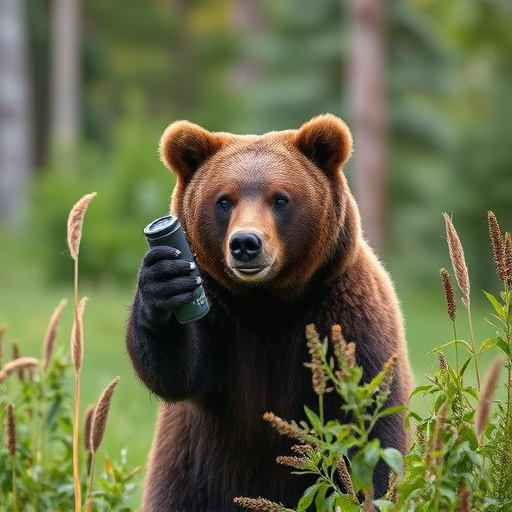Understanding wind direction is vital for effective bear spray deployment and safety. Strategically position yourself upwind to ensure the spray reaches the bear's face and eyes. Choose a suitable holster based on terrain – compact for forests, visible and quick-release for open areas. Adhere to safety protocols: face into the wind, secure the spray, know local laws, and remain vigilant outdoors. Train regularly in diverse scenarios to refine quick draw access and improve bear spray safety skills.
In the great outdoors, encountering a bear can be a thrilling yet potentially dangerous experience. Bear spray offers a critical self-defense mechanism, but effective deployment is key to ensuring safety. This article delves into essential aspects of bear spray holstering and usage, focusing on wind direction for optimal delivery, choosing the right holster for quick draw access, and safety protocols for responsible carrying. By understanding these elements, folks can navigate encounters with enhanced peace of mind and preparedness.
- Understanding Wind Direction for Effective Spray Delivery
- Choosing the Right Holster for Quick Draw Access
- Safety Protocols When Carrying Bear Spray
- Training and Practice for Optimal Reaction Time
Understanding Wind Direction for Effective Spray Delivery
Understanding wind direction is a crucial aspect of bear spray safety, as it directly impacts the effectiveness of your spray delivery. When deploying bear spray, aim for the face and eyes of the approaching bear, as this area contains sensitive nerve endings that can quickly incapacitate or deter the animal. However, be mindful of the wind; an unexpected gust could blow the spray back towards you or change its course, rendering it less effective or even hazardous.
To ensure optimal spray distribution, always check and monitor the wind direction before applying bear spray. If possible, position yourself upwind of the bear, allowing the spray to move with the wind towards its target. This strategic approach significantly increases your chances of a successful encounter and keeps you safe in unpredictable situations.
Choosing the Right Holster for Quick Draw Access
Choosing the right holster is paramount for quick draw access in bear spray safety. When selecting a holster, consider factors like fit, comfort, and ease of use. A well-fitted holster should allow for a swift and secure grab, ensuring your bear spray is ready when needed. For optimal wind direction management, some holsters feature adjustable retention straps or angle adjustments, enabling you to position the spray canister at an ideal angle regardless of the prevailing wind.
Remember that different environments demand varying holster designs. If you’re venturing into dense forests where close encounters with bears are more likely, a compact and lightweight holster might be preferable. Conversely, for open terrain where distance is key, a holster with enhanced visibility and quick-release mechanisms could prove beneficial. Always keep wind direction in mind—a secure but easily accessible bear spray holster won’t do you much good if the canister flies off during a confrontation due to strong winds.
Safety Protocols When Carrying Bear Spray
When carrying bear spray, understanding safety protocols is paramount. Always ensure your back is to the wind, as this prevents any accidental inhalation of the spray. Keep the can secured in a holster designed for quick draw access, allowing for swift deployment when needed. Familiarize yourself with local regulations and always store bear spray out of reach of children or pets. Regularly inspect your spray for any signs of damage or leakage to ensure its functionality.
During outdoor activities, remain aware of your surroundings. Keep a safe distance from known bear habitats and avoid areas with fresh bear sign. If you encounter a bear, make yourself appear larger by raising arms or wearing a jacket. Speak firmly but calmly to deter the bear. Remember, the goal is not to anger the bear but to convince it that you are not prey and can be potentially dangerous.
Training and Practice for Optimal Reaction Time
Training and practice are essential components of mastering quick draw access to bear spray, ensuring optimal reaction time in potentially dangerous encounters. The first step involves understanding wind direction, as it plays a crucial role in effective usage. Bear spray is designed to create a barrier between you and the bear, so knowing which way the wind is blowing allows for strategic deployment, maximizing its reach and minimizing exposure. Regular drills should include simulating various scenarios with different wind conditions to foster instinctive reactions.
Additionally, frequent practice sessions help refine muscle memory. Holding and drawing the spray canister should become second nature, allowing for swift response times. It’s important to train in diverse environments, considering terrain and obstacles that might affect access during an actual encounter. By combining these training techniques, individuals can enhance their bear spray safety skills and be better prepared to handle unexpected encounters with bears in the wild.
When it comes to bear spray, proper deployment at the right moment can be a life-saving skill. By understanding wind direction, selecting the ideal holster for quick draw access, adhering to safety protocols, and training diligently, outdoor enthusiasts can enhance their chances of staying safe in bear country. Remember, knowledge and preparation are key to navigating encounters with these majestic yet potent animals, ensuring a safer and more enjoyable outdoor experience.
